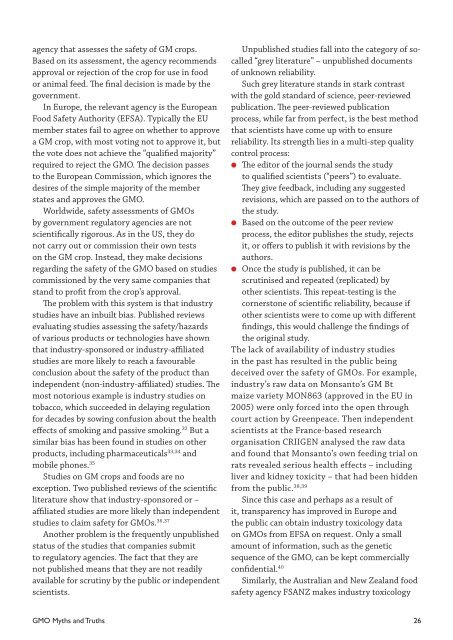GMO Myths and Truths
GMO Myths and Truths
GMO Myths and Truths
Create successful ePaper yourself
Turn your PDF publications into a flip-book with our unique Google optimized e-Paper software.
agency that assesses the safety of GM crops.<br />
Based on its assessment, the agency recommends<br />
approval or rejection of the crop for use in food<br />
or animal feed. The final decision is made by the<br />
government.<br />
In Europe, the relevant agency is the European<br />
Food Safety Authority (EFSA). Typically the EU<br />
member states fail to agree on whether to approve<br />
a GM crop, with most voting not to approve it, but<br />
the vote does not achieve the “qualified majority”<br />
required to reject the <strong>GMO</strong>. The decision passes<br />
to the European Commission, which ignores the<br />
desires of the simple majority of the member<br />
states <strong>and</strong> approves the <strong>GMO</strong>.<br />
Worldwide, safety assessments of <strong>GMO</strong>s<br />
by government regulatory agencies are not<br />
scientifically rigorous. As in the US, they do<br />
not carry out or commission their own tests<br />
on the GM crop. Instead, they make decisions<br />
regarding the safety of the <strong>GMO</strong> based on studies<br />
commissioned by the very same companies that<br />
st<strong>and</strong> to profit from the crop’s approval.<br />
The problem with this system is that industry<br />
studies have an inbuilt bias. Published reviews<br />
evaluating studies assessing the safety/hazards<br />
of various products or technologies have shown<br />
that industry-sponsored or industry-affiliated<br />
studies are more likely to reach a favourable<br />
conclusion about the safety of the product than<br />
independent (non-industry-affiliated) studies. The<br />
most notorious example is industry studies on<br />
tobacco, which succeeded in delaying regulation<br />
for decades by sowing confusion about the health<br />
effects of smoking <strong>and</strong> passive smoking. 32 But a<br />
similar bias has been found in studies on other<br />
products, including pharmaceuticals 33,34 <strong>and</strong><br />
mobile phones. 35<br />
Studies on GM crops <strong>and</strong> foods are no<br />
exception. Two published reviews of the scientific<br />
literature show that industry-sponsored or –<br />
affiliated studies are more likely than independent<br />
studies to claim safety for <strong>GMO</strong>s. 36,37<br />
Another problem is the frequently unpublished<br />
status of the studies that companies submit<br />
to regulatory agencies. The fact that they are<br />
not published means that they are not readily<br />
available for scrutiny by the public or independent<br />
scientists.<br />
Unpublished studies fall into the category of socalled<br />
“grey literature” – unpublished documents<br />
of unknown reliability.<br />
Such grey literature st<strong>and</strong>s in stark contrast<br />
with the gold st<strong>and</strong>ard of science, peer-reviewed<br />
publication. The peer-reviewed publication<br />
process, while far from perfect, is the best method<br />
that scientists have come up with to ensure<br />
reliability. Its strength lies in a multi-step quality<br />
control process:<br />
● The editor of the journal sends the study<br />
to qualified scientists (“peers”) to evaluate.<br />
They give feedback, including any suggested<br />
revisions, which are passed on to the authors of<br />
the study.<br />
● Based on the outcome of the peer review<br />
process, the editor publishes the study, rejects<br />
it, or offers to publish it with revisions by the<br />
authors.<br />
● Once the study is published, it can be<br />
scrutinised <strong>and</strong> repeated (replicated) by<br />
other scientists. This repeat-testing is the<br />
cornerstone of scientific reliability, because if<br />
other scientists were to come up with different<br />
findings, this would challenge the findings of<br />
the original study.<br />
The lack of availability of industry studies<br />
in the past has resulted in the public being<br />
deceived over the safety of <strong>GMO</strong>s. For example,<br />
industry’s raw data on Monsanto’s GM Bt<br />
maize variety MON863 (approved in the EU in<br />
2005) were only forced into the open through<br />
court action by Greenpeace. Then independent<br />
scientists at the France-based research<br />
organisation CRIIGEN analysed the raw data<br />
<strong>and</strong> found that Monsanto’s own feeding trial on<br />
rats revealed serious health effects – including<br />
liver <strong>and</strong> kidney toxicity – that had been hidden<br />
from the public. 38,39<br />
Since this case <strong>and</strong> perhaps as a result of<br />
it, transparency has improved in Europe <strong>and</strong><br />
the public can obtain industry toxicology data<br />
on <strong>GMO</strong>s from EFSA on request. Only a small<br />
amount of information, such as the genetic<br />
sequence of the <strong>GMO</strong>, can be kept commercially<br />
confidential. 40<br />
Similarly, the Australian <strong>and</strong> New Zeal<strong>and</strong> food<br />
safety agency FSANZ makes industry toxicology<br />
<strong>GMO</strong> <strong>Myths</strong> <strong>and</strong> <strong>Truths</strong> 26


